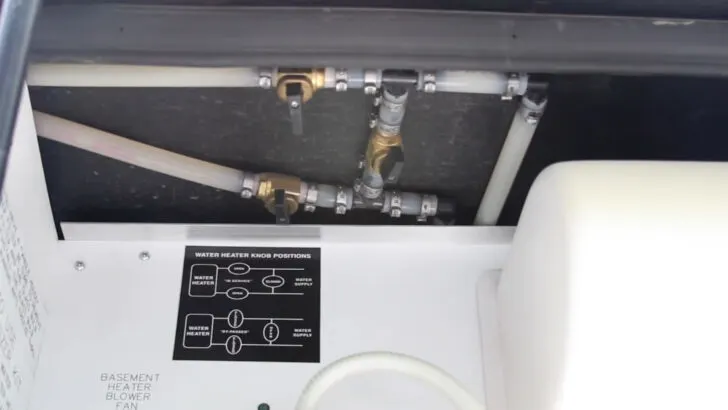We’ve been asked “How many gallons of RV antifreeze do I need to winterize my rig?” time and time again. But the answer to the question How much RV antifreeze do I need? depends on several factors.
Winterizing an RV’s plumbing system may not be difficult, but it is very important to do it right. Freezing temperatures come quickly and can do considerable damage to a rig that hasn’t been properly winterized. But there are many different sized rigs and there are a couple of different ways to winterize an RV.
So, in this post, we’ll tell you how many gallons of antifreeze are needed to winterize an RV… depending on how you choose to winterize!
What Is RV Antifreeze?
First, it’s important to note that RV antifreeze is not the same thing as automotive/engine antifreeze. The two are completely different products for different purposes.
Water expands when it freezes, which can cause RV pipes and plumbing fittings to burst. RV antifreeze is a bright pink liquid with a much lower freeze point than water. To prevent water from freezing in the system, RV antifreeze is pumped in to replace the water.
It’s designed to protect an RV’s plumbing system from damage when the temperature drops below the freezing point of water (32℉ / 0℃ of course). Some types of RV antifreeze also serve as a lubricant to protect seals inside RV toilets and faucets from cracking in the cold and from lack of use.
The biggest difference with RV antifreeze (as compared to engine antifreeze) is that it’s non-toxic to humans as long as it’s used properly. (In other words, don’t drink it. “Non-toxic” doesn’t mean it’s a beverage!)
RV antifreeze has a sweet scent and taste that can attract animals. And it can be toxic, especially to cats, even in small amounts. So be sure to use and store it properly.
While all RV antifreeze is intended to protect your RV’s plumbing system, it’s not all the same. Some are ethanol-based, some are propylene glycol-based, and, although it’s far less common, there is some RV antifreeze that is a blend of both ethanol and propylene glycol.
What Is the Safest Type of RV Antifreeze?
The safest option is propylene glycol-based antifreeze. Not only is it safe for all aspects of an RV plumbing system, but unlike ethanol-based antifreeze, propylene glycol-based antifreeze is non-flammable.
Propylene glycol also acts as a lubricant for faucets and toilet seals and leaves behind less of a taste in your freshwater plumbing than ethanol-based antifreeze. Propylene glycol antifreeze is also used as marine antifreeze for the winterization of the water systems in boats.
Some of these offer burst protection down to -50°F, or even as low as -100°F!
- No Burst Guarantee -100° F
- Safe for use in RVs/travel trailers , pools, boats and seasonal homes
How Many Gallons of Antifreeze to Winterize an RV?
If you’re wondering how much RV antifreeze to put in holding tanks (fresh, gray, and black water tanks), fear not! Your RV’s holding tanks aren’t a big issue when winterizing, so you won’t need 100+ gallons to get the job done! Holding tanks can be left empty, or nearly empty, to keep them from freezing. They have plenty of space for any frozen water at the bottom of the tank to expand during cold weather without causing damage.
We’d suggest that the fresh water tank is one of the most important places to avoid putting anti-freeze. That’s because it can be a real pain in the butt to flush it all out in the spring. A winterizing kit is required to avoid having to add anti-freeze to the fresh tank. If you’re RV didn’t come with one, it can usually be installed later.
- Use the RV water pump to fill the RV pipes with antifreeze.Fit Type: Universal Fit
- Comes complete with brass valve, siphon hose, Teflon tape and pump adapters (pump not included)
The pressurized plumbing system is most important, and that’s what we’ll be focusing on. You need to protect your RV’s PEX water lines and fittings, the water pump, sink & shower drains, and the P-traps from freezing.
The amount of antifreeze needed to do the job right depends on how you intend to winterize your rig.
Blowing Out Water Lines + Antifreeze
Many RV owners (us included) blow the water out of their RV’s plumbing system using compressed air. But that still requires some anti-freeze. If you plan to winterize your RV using RV antifreeze only, you’ll need a lot more of it to do the job than you will if you blow out your water lines with compressed air first.
An air compressor removes the water from your plumbing system by replacing it with air. If you choose to blow out your water lines, you’ll only need to have about a gallon of RV antifreeze on hand, and you likely won’t even need to use the entire gallon. But you’ll still need to use some antifreeze even when blowing out all of the water lines first.
You’ll want to put some antifreeze down each drain to protect P-traps, and you should pour some into your toilet bowl to help protect the seal. You may also need to use antifreeze to protect certain appliances such as a washing machine and/or dishwasher if you have them.
You’ll also need an air compressor capable of doing the job. We especially like Viair compressors for winterizing our rig and for adding air to our tires when needed.
- PORTABLE *AUTOMATIC* COMPRESSOR for RVs & TRAILERS (Model: 40047, 150 PSI, Class C Tires) - Hit the open road with a reliable 12V air compressor,...
- POWER YOUR JOURNEY: Versatile Air Compressor for RVs & More. The 400P-RV Portable RV Air Compressor is your go-to solution for inflating tires on RVs,...
You can also buy Viair products through TechnoRV. If you do so, be sure to use the RVGEEKS discount coupon for 5% off.
TechnoRV.com is a supplier of leading RV technology products that are designed to enhance your RV lifestyle. That includes items like LevelMatePRO, Viair portable air compressors, connectivity...Show More
TechnoRV.com is a supplier of leading RV technology products that are designed to enhance your RV lifestyle. That includes items like LevelMatePRO, Viair portable air compressors, connectivity equipment, and more!
Use the Promo Code "RVGEEKS" to save 5% on your entire order at TechnoRV.
Show LessYou can also buy Viair products through MobileMustHave.com using our coupon for 5% off.
Thanks to the latest additions to our RV internet arsenal from MobileMustHave, we're able to stay connected more reliably... and more remotely... than we ever could before. We couldn't be happier...Show More
Thanks to the latest additions to our RV internet arsenal from MobileMustHave, we're able to stay connected more reliably... and more remotely... than we ever could before. We couldn't be happier with the equipment we now have!
Upgrade your RV internet connectivity with great products from Peplink, WeBoost, Parsec, Poynting, Mobile Mark, and more. And while you're there, look at other great products like Viair Compressors!
Watch our video about our RV internet connectivity solutions for 2021
Save 5% on your equipment order at MobileMustHave.com when you click the button on this deal or use discount code "RVGEEKS" at checkout!
Show LessFor complete details showing the step-by-step process of our preferred winterizing method, check out our post on how to winterize an RV with an air compressor.
Winterizing with Antifreeze Only
Winterizing your entire RV plumbing system using RV antifreeze only (no compressor) is also an option. You should need at least 2-4 gallons of antifreeze. But depending on the size of your rig and how the plumbing is configured you might need as much as 6-12 gallons. We’ll explain the reasons for that large range below.
The process of winterizing an RV using only antifreeze begins with allowing gravity to start draining the plumbing. Open any low-point drains for the plumbing system and freshwater tank, and completely drain all the clean water out onto the ground.
You’ll also want to empty your wastewater holding tanks at a dump station or full hook-up campsite. If you have a black tank flush, be sure to use it before storing your rig for the winter.
You’ll also want to empty your water heater tank (this is a great time to flush and clean it, too). In most cases, you’ll bypass the water heater by turning the bypass valve(s). That way, you’ll be omitting the water heater as you winterize your rig, by effectively cutting it off from the rest of the RV’s plumbing system.
But… not every RV has the ability to bypass the water heater. Most do, but not all. This is where you’ll find the biggest difference when asking “How much antifreeze do I need to winterize my RV?” — whether or not your RV has a water heater bypass.
Again, most RVs are equipped with a water heater bypass system. It’s generally one, two, or three valves near the water heater. Turning the valve(s) 90 degrees does exactly what the name implies: bypasses the flow of water around (instead of through) the water heater. Keep in mind that the valves are often hidden in a cabinet, or in the basement, very close to the water heater.

This shows the three water heater bypass valves on our Newmar Mountain Aire. Turning these valves 90 degrees will block the water supply to and from the water heater, effectively cutting it off from the RV’s plumbing system. (The valves are currently set to bypass mode.)
Bypassing the water heater allows you to pump antifreeze through the RV’s plumbing system without adding any into the water heater. The good news is that RV water heaters only need to be drained, not filled with antifreeze. The small amount of water left at the bottom of the tank can freeze without causing harm because there’s plenty of space in the tank for it to expand (similar to the RV’s holding tanks).
With the water heater bypassed, you only need enough anti-freeze to fill the fresh water lines up to the faucets, which should be no more than about 2-3 gallons, even on a larger RV. Add to that the anti-freeze you’ll want to put into the drains/P-traps and toilet (as mentioned above), and 4 gallons should be more than enough to winterize any RV that’s equipped with a water heater bypass.
PRO TIP: Buy more anti-freeze than you think you’ll need. Running out in the middle of the job really sucks, and you can keep any leftover for next year.
If your rig doesn’t have a hot water bypass, you’ll have no choice but to add RV antifreeze to the hot water tank during winterizing. This of course uses more antifreeze and also requires an especially good rinse-out in the spring (which is easy to do). Other than that, it’s no big deal, and not harmful. Either way, be sure to drain the water heater first.
The good news is that the most likely RVs to come without a water heater bypass are also the smallest models. That means less plumbing overall and a smaller water heater. An RV without a water heater bypass is unlikely to have a water heater tank that’s larger than 6 gallons (although it is possible).
Even if you completely filled a 6-gallon water heater with anti-freeze, that extra volume, added to the 4 gallons we already mentioned for plumbing and drains, means that about 10 gallons is the most anti-freeze any RV would likely need. But again, it would be unusual to need that much, as most RVs do have water heater bypass valves.
Here’s how to empty and flush a typical tank-style RV water heater:
NOTE: For on-demand water heaters, be sure to follow the manufacturer’s instructions for winterizing. Some can just be drained, others may require you to protect them with antifreeze.
To avoid common winterizing mistakes, be sure to check out our RV winterizing tips.
Free RVing Tips, Tricks, Reviews & Giveaways
As 20-year full-timers, we share everything we’ve learned about RVing over the years. Join our online community to receive a wealth of great RVing knowledge delivered daily to your inbox.
Whether you’re a new RVer or a seasoned full-timer, you’ll love the wide range of RVing topics we cover. Don’t miss a single article or any of our famous Giveaways. Subscribe to our newsletter today!







